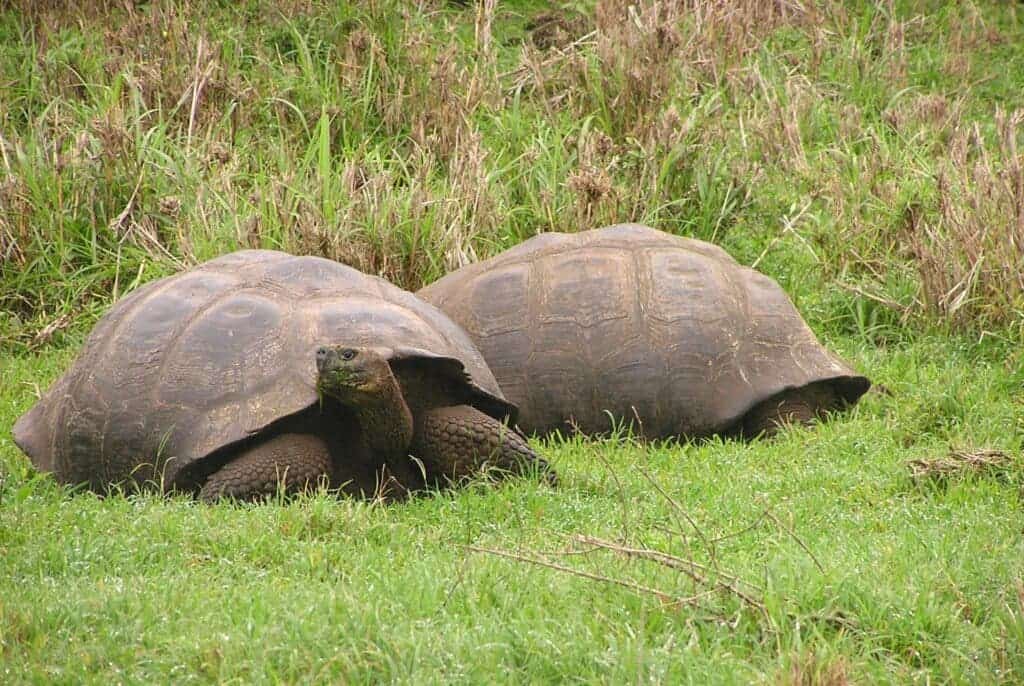
Galápagos giant tortoises are one of the longest-lived vertebrates, with many living past 100 years of age in the wild. In captivity, they can live even longer. One captive individual, Harriet, lived for at least 175 years. How do they do it? In a new study, researchers at the University of Buffalo compared the genomes of Galápagos giant tortoises with those of other turtles and found the animals evolved to have extra copies of certain genes. These extra copies are thought to offer protection against the biological degeneration typically associated with aging, including cancer.
The new study builds upon past research performed in 2018. Back then, Yale University and Universidad de Oviedo, Spain, sequenced the genome of the famous Lonesome George, who died in 2012 at age of 100 and was the last giant tortoise on Pinta Island. When researchers compared Lonesome George’s genome, as well as that of the Aldabra giant tortoise (Aldabrachelys gigantea), to other species, they found genes associated with metabolism regulation and immune response.
These genes may explain the generous size and long lifespans of these species. The researchers have found that tumor suppressors are expanded in the tortoises’ genomes compared to other vertebrates. The analysis also found specific alterations in two genes whose overexpression is known to contribute to cancer, and which may be part of a giant-tortoise-specific cancer mechanism.
But it’s not only the genes themselves that may offer protection against cancer. The new study found that giant tortoises have extra copies of genes, an indirect consequence of a defense mechanism they evolved in order to cope with stress related to damaged proteins.
Experiments on cells cultured from Galápagos giant tortoises showed that they self-destruct faster and easier than those of other turtle cells when exposed to stressors. That may sound like a poor defense mechanism, but this proclivity for self-destruction protects the giant tortoises from biological glitches that can form tumors, thereby helping the animals evade cancer.
“In the lab, we can stress the cells out in ways that are associated with aging and see how well they resist that distress. And it turns out that the Galápagos tortoise cells are really, really good at killing themselves before stress has a chance to cause diseases like cancer,” said Vincent Lynch, an evolutionary biologist at the University at Buffalo and co-author of the new study.
Very large animals like the Galápagos giant tortoises, which can weigh as much as 300 kg (660 lbs) and can grow to be 1.3 m (4 ft) long, ought to be more prone to cancer because, all other things being equal, they have more cells in their bodies. The more cells, the greater the statistical odds that some mutations arise that can lead to cancer. But since the 1970s, scientists have found that there is no relationship between body size and cancer incidence, a counter-intuitive phenomenon known as Peto’s Paradox after English statistician and epidemiologist Richard Peto, who first observed the connection.
In fact, one of the largest animals in the world, the bowhead whale, is virtually cancer free. On land, only a fraction of elephants get cancer compared to 1 in 5 humans. Why exactly some of the largest animals have such long lives is a major avenue of research with important implications for our cancer-prone species.
“If you can identify the way nature has done something — the way certain species have evolved protections — maybe you can find a way to translate those discoveries into something that benefits human health and disease,” Lynch says. “We’re not going to go treating humans with Galápagos tortoise genes, but maybe we can find a drug that mimics certain important functions.”
The authors of the new study add that their research also carries a message about conservation. Five subspecies of the Galápagos tortoise have been extinct since they were first studied by Charles Darwin, who used their evolutionary defenses, like a distinct shell, to define his theory of natural selection. Over 100,000 have been killed over the centuries by hunters, pirates and whalers who ate the tortoises on their travels. Although not endangered, the Galápagos tortoise is listed as a vulnerable species.
“Studies like this demonstrate why preserving biodiversity is so important,” says Scott Glaberman, the paper’s first author and an assistant professor of environmental science and policy at George Mason University. “Extreme species like Galápagos giant tortoises probably hold many secrets for dealing with major human challenges like aging and cancer, and even climate change. Our study also shows that even within turtles, different species look, act and function differently, and losing any species to extinction means that a piece of unique biology will be lost to the world forever.”
The findings appeared in the journal Genome Biology and Evolution.


